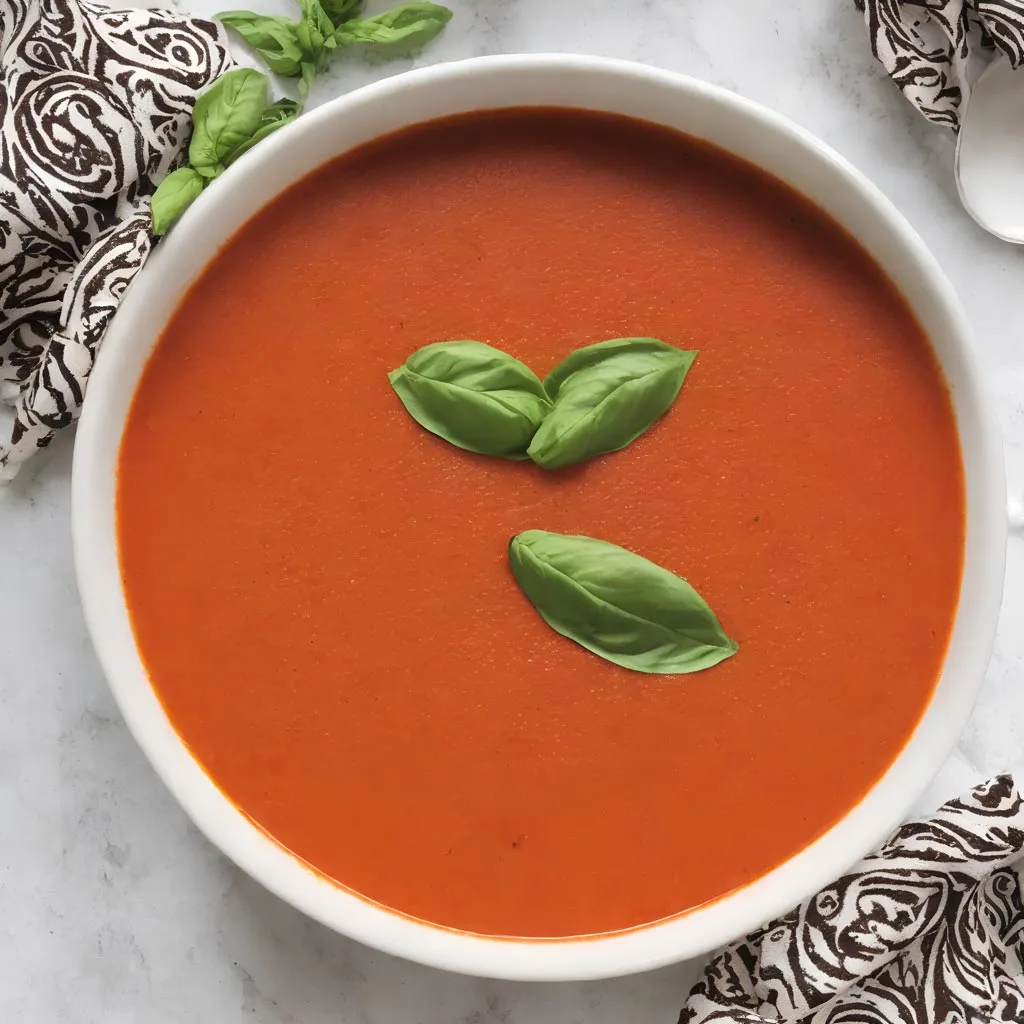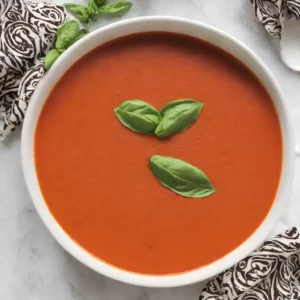
Tomato soup, a classic comfort food enjoyed around the world, brings warmth and satisfaction with each spoonful. Its origins trace back centuries, with variations found in cuisines from Europe to Asia. This recipe offers a simple yet flavorful rendition, perfect for cozy evenings or as a starter to a heartwarming meal.
Crafted with ripe, juicy tomatoes as the star ingredient, this soup is a celebration of freshness and simplicity. Enhanced by the sweetness of caramelized onions and the aromatic essence of garlic, each component harmonizes to create a symphony of flavors. The addition of tomato puree intensifies the tomato essence, elevating the soup’s richness.
Vegetable stock provides a savory foundation, while a hint of sugar balances the acidity of the tomatoes, resulting in a well-rounded taste. Seasoned with salt and pepper to enhance the flavors, this soup offers a comforting familiarity with every spoonful. Optionally, garnish with fresh basil for a burst of herbal freshness.
Expert Tip: Customize the soup to suit your taste preferences by adjusting the seasoning. Add more salt, pepper, or herbs as needed to achieve the perfect balance of flavors.
Tomatoes: Ripe and roughly chopped, tomatoes form the base of this soup, providing a vibrant color and a burst of natural sweetness.
Olive Oil: Used for sautéing the onions and garlic, olive oil adds a rich, fruity flavor and helps to enhance the overall taste of the soup.
Onion: Chopped and caramelized, onions impart a subtle sweetness and depth of flavor, complementing the acidity of the tomatoes.
Garlic: Minced and sautéed, garlic infuses the soup with its distinctive aroma and adds a savory complexity to the dish.
Tomato Puree: Intensifying the tomato flavor, tomato puree contributes to the soup’s richness and depth, creating a luscious texture.
Vegetable Stock: Providing a savory base, vegetable stock enhances the umami profile of the soup, adding depth and complexity.
Sugar: Balancing the acidity of the tomatoes, sugar rounds out the flavors, resulting in a harmonious taste experience.
Salt and Black Pepper: To taste, salt and black pepper season the soup, elevating its flavors and enhancing its overall taste.
Basil: Optional, chopped basil leaves add a fresh, herbal note to the soup, enhancing its aroma and visual appeal.
Expert Tip: To enhance the flavor of the soup, roast the tomatoes in the oven before adding them to the pot. This intensifies their sweetness and adds depth to the overall taste.
Expert Tip: For a smoother soup texture, strain the pureed soup through a fine mesh sieve after blending to remove any remaining solids.
Tomato soup can be stored in an airtight container in the refrigerator for up to 4-5 days. Make sure to cool the soup completely before storing it to maintain its freshness.
Yes, tomato soup freezes well. Allow the soup to cool completely, then transfer it to freezer-safe containers or resealable bags. It can be stored in the freezer for up to 2-3 months. Thaw the soup overnight in the refrigerator before reheating.
Yes, canned tomatoes can be used as a substitute for fresh tomatoes in this recipe. Opt for high-quality canned tomatoes for the best flavor. You may need to adjust the seasoning slightly, as canned tomatoes can vary in acidity and salt content.
Absolutely! This tomato soup recipe is already vegan-friendly as it uses vegetable stock instead of chicken or beef broth. Just make sure to check that all the ingredients you use are plant-based and free from animal products.
Yes, you can add a splash of cream to the soup for added richness and creaminess. Simply stir in the cream just before serving, or drizzle it over individual bowls as a garnish.
Here are some more recipes for you to enjoy! If you my recipes don’t forget to rate and leave a comment.
If you have any recipe suggestions, please do not hesitate to ask me. A great way to stay in contact with me is through Instagram, Facebook, Twitter and YouTube. Don’t forget to tag me @CookwithNabeela in your recipe photos!

Subscribe now to receive my latest recipes directly in your inbox. Stay up-to-date and never miss out!

I love to cook! I want to share with you my favourite, delicious family-friendly recipes. I want to inspire you to create fantastic food for your family every day.
Add your first comment to this post